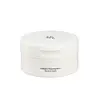What's inside
What's inside
 Key Ingredients
Key Ingredients

 Benefits
Benefits

 Concerns
Concerns

 Ingredients Side-by-side
Ingredients Side-by-side

Ethylhexyl Palmitate
EmollientSorbeth-30 Tetraoleate
EmulsifyingCetyl Ethylhexanoate
EmollientIsopropyl Palmitate
EmollientPropylene Glycol Dicaprylate/Dicaprate
EmollientTriethylhexanoin
MaskingSynthetic Wax
AbrasiveZea Mays Germ Oil
EmollientSilica Dimethyl Silylate
EmollientButyrospermum Parkii Butter
Skin ConditioningCaprylic/Capric Triglyceride
Masking1,2-Hexanediol
Skin ConditioningCitrullus Lanatus Fruit Extract
Skin ConditioningButylene Glycol
HumectantGlycerin
HumectantHydrolyzed Hyaluronic Acid
HumectantPotassium Hyaluronate
Skin ConditioningPentaerythrityl Tetra-Di-T-Butyl Hydroxyhydrocinnamate
AntioxidantWater
Skin ConditioningSodium Hyaluronate
HumectantHyaluronic Acid
HumectantCaprylyl Glycol
EmollientHydroxypropyltrimonium Hyaluronate
Sodium Acetylated Hyaluronate
HumectantPalmitoyl Tetrapeptide-7
Skin ConditioningAcetyl Hexapeptide-8
HumectantCopper Tripeptide-1
Skin ConditioningNonapeptide-1
Skin ConditioningTripeptide-1
Skin ConditioningPalmitoyl Pentapeptide-4
Skin ConditioningPalmitoyl Tripeptide-1
Skin ConditioningHexapeptide-9
Skin ConditioningPalmitoyl Hexapeptide-12
Skin ConditioningSodium Hyaluronate Crosspolymer
HumectantButeth-3
SolventSodium Benzotriazolyl Butylphenol Sulfonate
UV AbsorberTributyl Citrate
SolventEclipta Prostrata Extract
Skin ConditioningMelia Azadirachta Leaf Extract
Skin ConditioningMoringa Oleifera Seed Oil
EmollientEthylhexyl Palmitate, Sorbeth-30 Tetraoleate, Cetyl Ethylhexanoate, Isopropyl Palmitate, Propylene Glycol Dicaprylate/Dicaprate, Triethylhexanoin, Synthetic Wax, Zea Mays Germ Oil, Silica Dimethyl Silylate, Butyrospermum Parkii Butter, Caprylic/Capric Triglyceride, 1,2-Hexanediol, Citrullus Lanatus Fruit Extract, Butylene Glycol, Glycerin, Hydrolyzed Hyaluronic Acid, Potassium Hyaluronate, Pentaerythrityl Tetra-Di-T-Butyl Hydroxyhydrocinnamate, Water, Sodium Hyaluronate, Hyaluronic Acid, Caprylyl Glycol, Hydroxypropyltrimonium Hyaluronate, Sodium Acetylated Hyaluronate, Palmitoyl Tetrapeptide-7, Acetyl Hexapeptide-8, Copper Tripeptide-1, Nonapeptide-1, Tripeptide-1, Palmitoyl Pentapeptide-4, Palmitoyl Tripeptide-1, Hexapeptide-9, Palmitoyl Hexapeptide-12, Sodium Hyaluronate Crosspolymer, Buteth-3, Sodium Benzotriazolyl Butylphenol Sulfonate, Tributyl Citrate, Eclipta Prostrata Extract, Melia Azadirachta Leaf Extract, Moringa Oleifera Seed Oil
Cetyl Ethylhexanoate
EmollientCaprylic/Capric Triglyceride
MaskingPEG-20 Glyceryl Triisostearate
EmollientSynthetic Wax
AbrasivePEG-10 Isostearate
EmulsifyingLactobacillus/Soybean Ferment Extract
Skin ConditioningHippophae Rhamnoides Oil
EmollientOryza Sativa Bran Oil
EmollientOryza Sativa Seed Water
AntimicrobialAvena Sativa Meal Extract
SoothingCoix Lacryma-Jobi Ma-Yuen Seed Extract
Skin ConditioningOryza Sativa Extract
AbsorbentWater
Skin ConditioningSorbitan Sesquioleate
EmulsifyingGlycerin
HumectantPropanediol
SolventButylene Glycol
Humectant1,2-Hexanediol
Skin ConditioningCaprylyl Glycol
EmollientEthylhexylglycerin
Skin ConditioningCetyl Ethylhexanoate, Caprylic/Capric Triglyceride, PEG-20 Glyceryl Triisostearate, Synthetic Wax, PEG-10 Isostearate, Lactobacillus/Soybean Ferment Extract, Hippophae Rhamnoides Oil, Oryza Sativa Bran Oil, Oryza Sativa Seed Water, Avena Sativa Meal Extract, Coix Lacryma-Jobi Ma-Yuen Seed Extract, Oryza Sativa Extract, Water, Sorbitan Sesquioleate, Glycerin, Propanediol, Butylene Glycol, 1,2-Hexanediol, Caprylyl Glycol, Ethylhexylglycerin
 Reviews
Reviews

Ingredients Explained
These ingredients are found in both products.
Ingredients higher up in an ingredient list are typically present in a larger amount.
1,2-Hexanediol is a synthetic liquid and another multi-functional powerhouse.
It is a:
- Humectant, drawing moisture into the skin
- Emollient, helping to soften skin
- Solvent, dispersing and stabilizing formulas
- Preservative booster, enhancing the antimicrobial activity of other preservatives
Butylene Glycol (or BG) is used within cosmetic products for a few different reasons:
Overall, Butylene Glycol is a safe and well-rounded ingredient that works well with other ingredients.
Though this ingredient works well with most skin types, some people with sensitive skin may experience a reaction such as allergic rashes, closed comedones, or itchiness.
Learn more about Butylene GlycolThis ingredient is an emollient, solvent, and texture enhancer. It is considered a skin-softener by helping the skin prevent moisture loss.
It helps thicken a product's formula and makes it easier to spread by dissolving clumping compounds.
Caprylic Triglyceride is made by combining glycerin with coconut oil, forming a clear liquid.
While there is an assumption Caprylic Triglyceride can clog pores due to it being derived from coconut oil, there is no research supporting this.
Learn more about Caprylic/Capric TriglycerideCaprylyl Glycol is a humectant and emollient, meaning it attracts and preserves moisture.
It is a common ingredient in many products, especially those designed to hydrate skin. The primary benefits are retaining moisture, skin softening, and promoting a healthy skin barrier.
Though Caprylyl Glycol is an alcohol derived from fatty acids, it is not the kind that can dry out skin.
This ingredient is also used as a preservative to extend the life of products. It has slight antimicrobial properties.
Learn more about Caprylyl GlycolCetyl Ethylhexanoate is an emollient ester. It comes from cetearyl alcohol and 2-ethylhexanoic acid.
Cetyl Ethylhexanoate is an emollient that adds a velvety feel to skin without being greasy or oily. Emollients help trap moisture into your skin, keeping your skin soft and hydrated.
Glycerin is already naturally found in your skin. It helps moisturize and protect your skin.
A study from 2016 found glycerin to be more effective as a humectant than AHAs and hyaluronic acid.
As a humectant, it helps the skin stay hydrated by pulling moisture to your skin. The low molecular weight of glycerin allows it to pull moisture into the deeper layers of your skin.
Hydrated skin improves your skin barrier; Your skin barrier helps protect against irritants and bacteria.
Glycerin has also been found to have antimicrobial and antiviral properties. Due to these properties, glycerin is often used in wound and burn treatments.
In cosmetics, glycerin is usually derived from plants such as soybean or palm. However, it can also be sourced from animals, such as tallow or animal fat.
This ingredient is organic, colorless, odorless, and non-toxic.
Glycerin is the name for this ingredient in American English. British English uses Glycerol/Glycerine.
Learn more about GlycerinSynthetic Wax is created from fossil fuels such as natural gas. It is used to enhance texture, adjust pH, and as an occlusive.
It may also be used as an abrasive ingredient to exfoliate the skin.
Synthetic Wax may not be fungal acne safe.
Learn more about Synthetic WaxWater. It's the most common cosmetic ingredient of all. You'll usually see it at the top of ingredient lists, meaning that it makes up the largest part of the product.
So why is it so popular? Water most often acts as a solvent - this means that it helps dissolve other ingredients into the formulation.
You'll also recognize water as that liquid we all need to stay alive. If you see this, drink a glass of water. Stay hydrated!
Learn more about Water